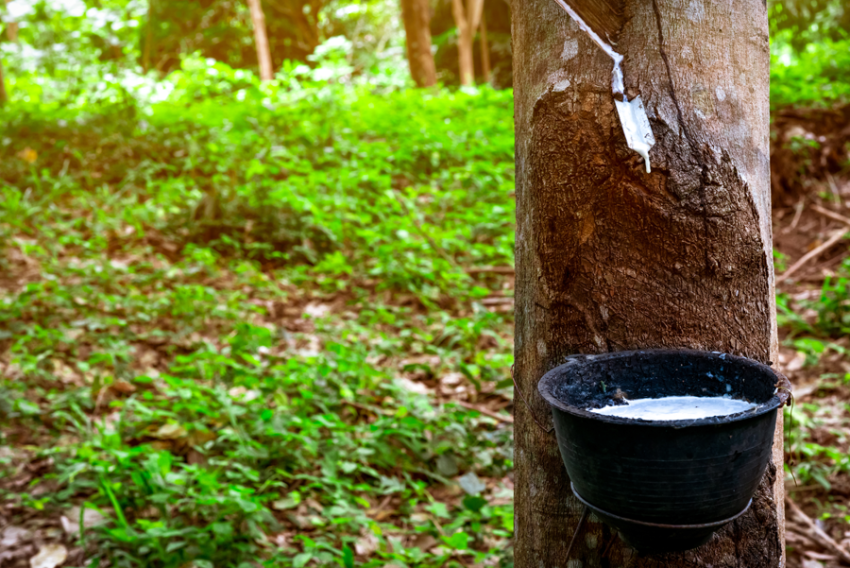Many of the materials used in tyre construction are oil derivatives, making tyres dependent on a limited resource with a high environmental impact, which is why both manufacturers and research institutions are striving to find sustainable materials.
The term 'rubber' denotes a wide variety of materials, all characterised by being made of elastomers, polymeric materials with a low Young's modulus (they deform easily when a force is applied) and high elasticity, enabling them to quickly recover their original state when the force that deformed them ceases. Elastic' polymers can be classified into two major groups: chemically cross-linked/cross-linkable elastomers (Cce) and physically cross-linked thermoplastic elastomers (Tpe). This difference relates to how the cross-linking - the process that creates the bonds between the polymer chains and thus gives the elastomers their elastic properties - takes place. Cce elastomers are generally more resilient and enjoy a higher operating temperature due to the networks of three-dimensional bonds that are created during cross-linking; we note that cross-linkable elastomers are generally referred to as rubber, compounds whose properties can be moulded to suit the required applications by means of a variety of specific additives.
Seeking to replace fossil fuels
To date, almost all commercial synthetic elastomers are obtained from fossil resources, making it vital to develop bio-based elastomers in order to reduce carbon emissions and dependence on such resources, which are in any case destined to be depleted and often at the centre of geopolitical tensions. This is far from simple as oil represents a readily available and abundant source of those organic molecules that are the 'building blocks' of polymeric chains. For example, up to 85 per cent of the weight of a tyre is made of polymeric materials and substances derived from oil. According to some sources, tyres consume about 60% of the global rubber supply, 60% of which is synthetic. This artificial rubber is totally dependent on hydrocarbons such as diesel oil, ethane and benzene, which are derived from non-renewable sources such as oil and methane; it should be noted that these compounds represent only a small part of the world's petrochemical production. Elastomers for tyre production, whether based on fossil or renewable sources, would need to be produced in large volumes, have a relatively low cost, and possess suitable physical properties. Petroleum-derived materials that meet these conditions are styrene butadiene (Sbr) and polybutadiene (Br) found in most tyre components, including treads and sidewalls; butyl-based variants are produced in lower volumes but are very important for low-permeability inner linings.
Alternative and sustainable production
Research developed by scientists from the Beijing University of Chemical Technology and the Laboratory of Reactions and Process Engineering at the University of Lorraine in Nancy, France, focused on bio-based elastomers derived from biomass such as cellulose, starch and vegetable oil and describes the properties of Cce and Tpe polymers produced from renewable sources. Bio-Cce include natural rubber and bio-based synthetic elastomers. Natural rubbers obtained from plants of the genus Hevea - which, however, only grow in the tropics - are currently the only ones of biological origin available on a large scale. Second-generation natural rubbers are extracted from different plants such as dandelion, guayule and Eucommia Ulmoides, all species that can be cultivated in more temperate latitudes. Dandelion rubber, also called Tks or Dr, is a promising alternative because Taraxacum (the scientific name for dandelion) can be grown at high latitudes and its roots contain between 5 and 24% of a rubber similar to Hevea rubber.
Its mechanical properties are good and strategies to increase its production have already been identified, such as the selection of new species, genetic modification, better conditions in which to cultivate it and optimisation of the extraction process. Synthetic bio-based elastomers, on the other hand, are derived from bio-based monomers. Guayule is a drought-resistant shrub native to the southwestern US and northern Mexico with a rubber content typically of 8-12%. The rubber extracted from this plant has a slightly higher elongation property than Hevea and dandelion rubber because it has a lower branched polymer content. The first guayule rubber car tyre was produced in 2017 and its life-cycle energy consumption was 13.7 GJ/tyre, significantly lower than that of a conventional rubber tyre - 16.4 GJ/tyre (3805.6 kWh versus 4555.6 kWh).
Sustainable fillers too
Rubber extracted from the Eucommia ulmoides (a small tree native to China), generally accumulates in the leaves, bark, roots and other parts of the plant and, unlike its Hevea, gayoule and dandelion counterpart, it is mainly composed of trans-1,4-polyisoprene rather than polyisoprene, which gives it a strong ability to crystallise at room temperature. More similar to a rigid plastic with a high tensile strength but can be converted into an elastomer by hydrogenation. Efforts are being made to expand the applications of this rubber in tyres and shape memory materials: by curing it with a polyolefin elastomer, a satisfactory shape recovery of over 95% is achieved. Genetic modifications are being studied to increase production and a research group from Beijing University of Chemical Technology together with Ling Long Tire have built a pilot plant to extract dandelion and Eucommia rubber with an annual production capacity of 100 tonnes. Another study, conducted by researchers from the Polytechnic of Turin, the CNR and the Italian Institute of Technology, examined the potential of Biochar - Bc - which is the solid residue obtained by thermal cracking of biomass, including waste, in an oxygen-poor atmosphere. The use of Bc as a filler in polymer-based composites, including the elastomers used in tyres, has attracted attention, and the study highlighted several advantages in the use of Bc, starting with its cost-effectiveness. Biochar, in fact, costs less than classic carbon black, which, in turn, is much cheaper than graphene or carbon nanotube fillers.
Tomato enzymes, new tyre frontier
Bc promises improved mechanical properties, electrical conductivity and thermal stability of compounds, as well as a full inclusion in the circular economy, but further studies are needed, e.g. to evaluate improved particle size, weathering and UV resistance, and potential degradation. In conclusion we must also mention research, currently being conducted by Sumitomo Rubber Industries, which highlights the use of modified tomato enzymes as a polymerisation catalyst able to select the initial polymer monomers. SRI reports that “we have now succeeded in synthesising biopolymers that incorporate initial monomers that are more conducive to improving tyre performance. It has been possible to synthesise 'new biopolymers that incorporate freely selected initial monomers”. Sumitomo believes that this biotechnology can not only improve the sustainability of its tyres but also develop products “that will take fuel efficiency to new levels by 2040 and beyond”.


